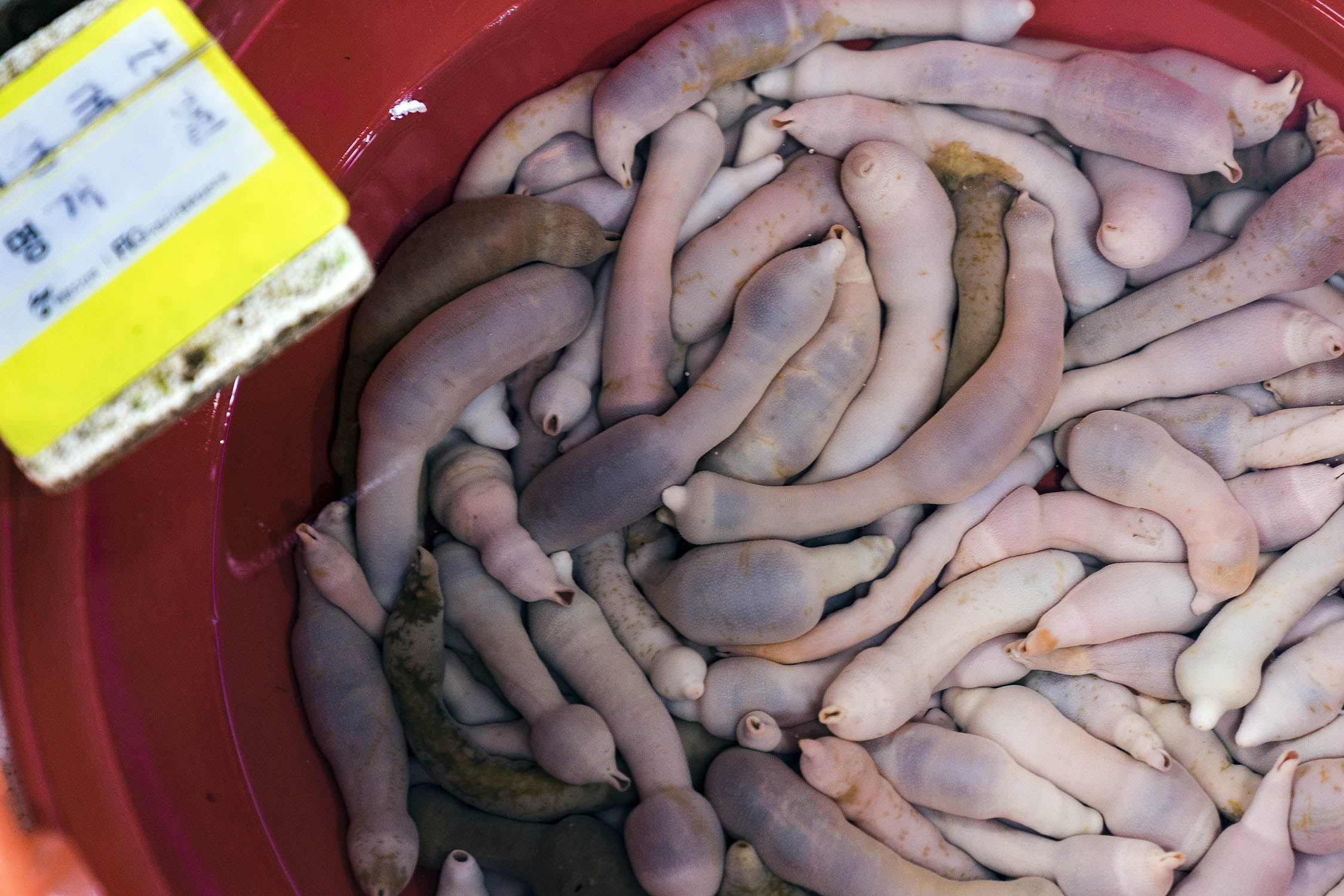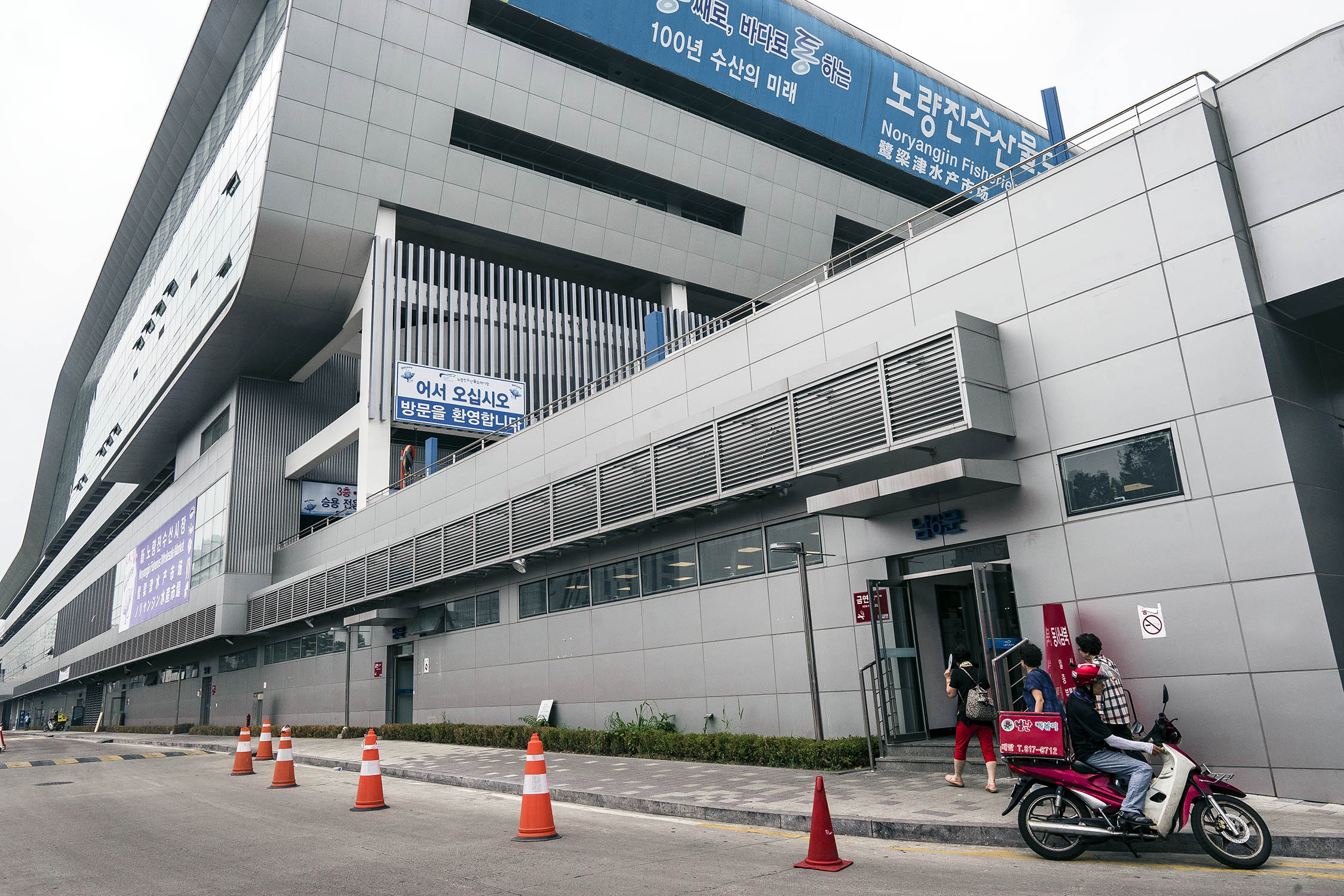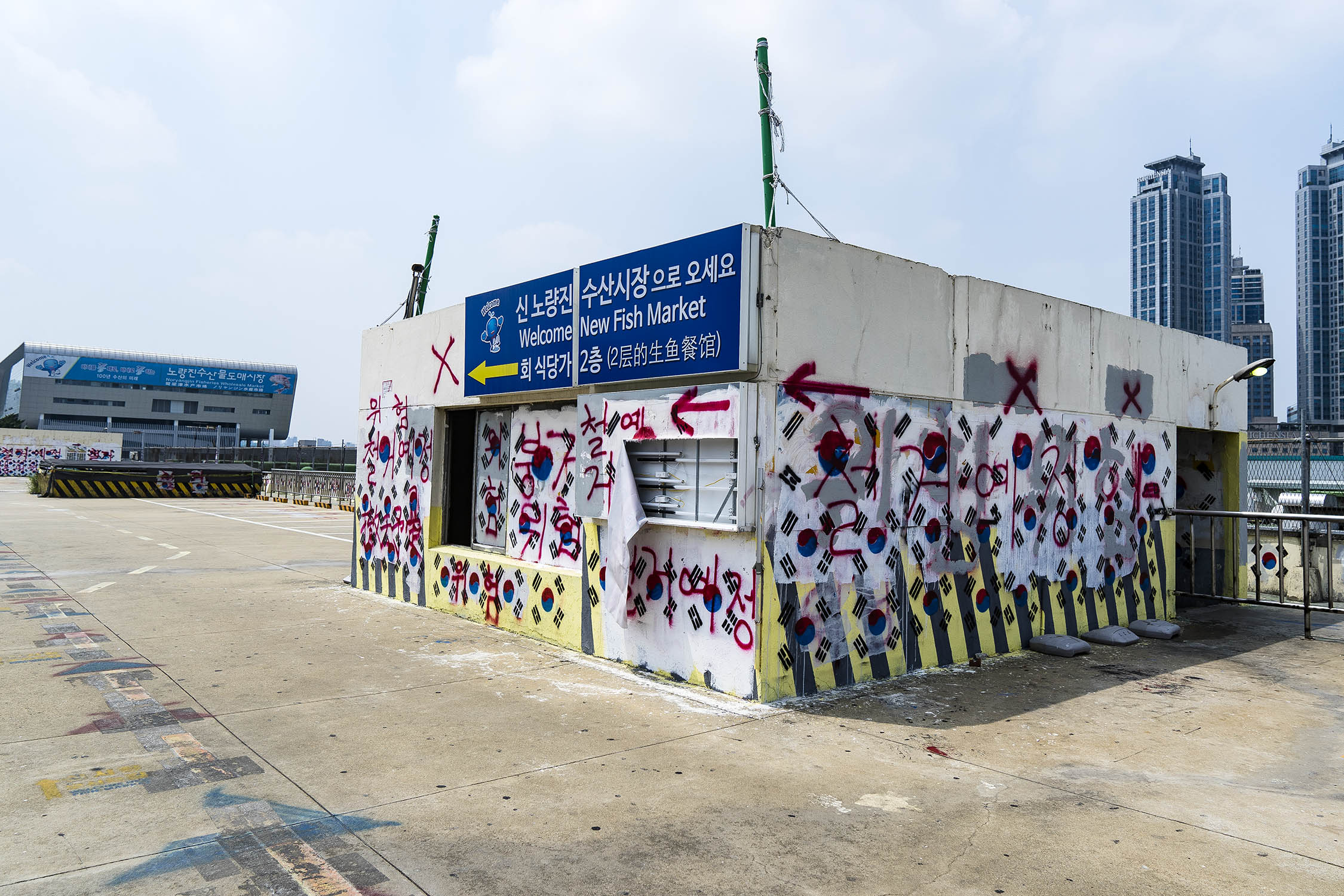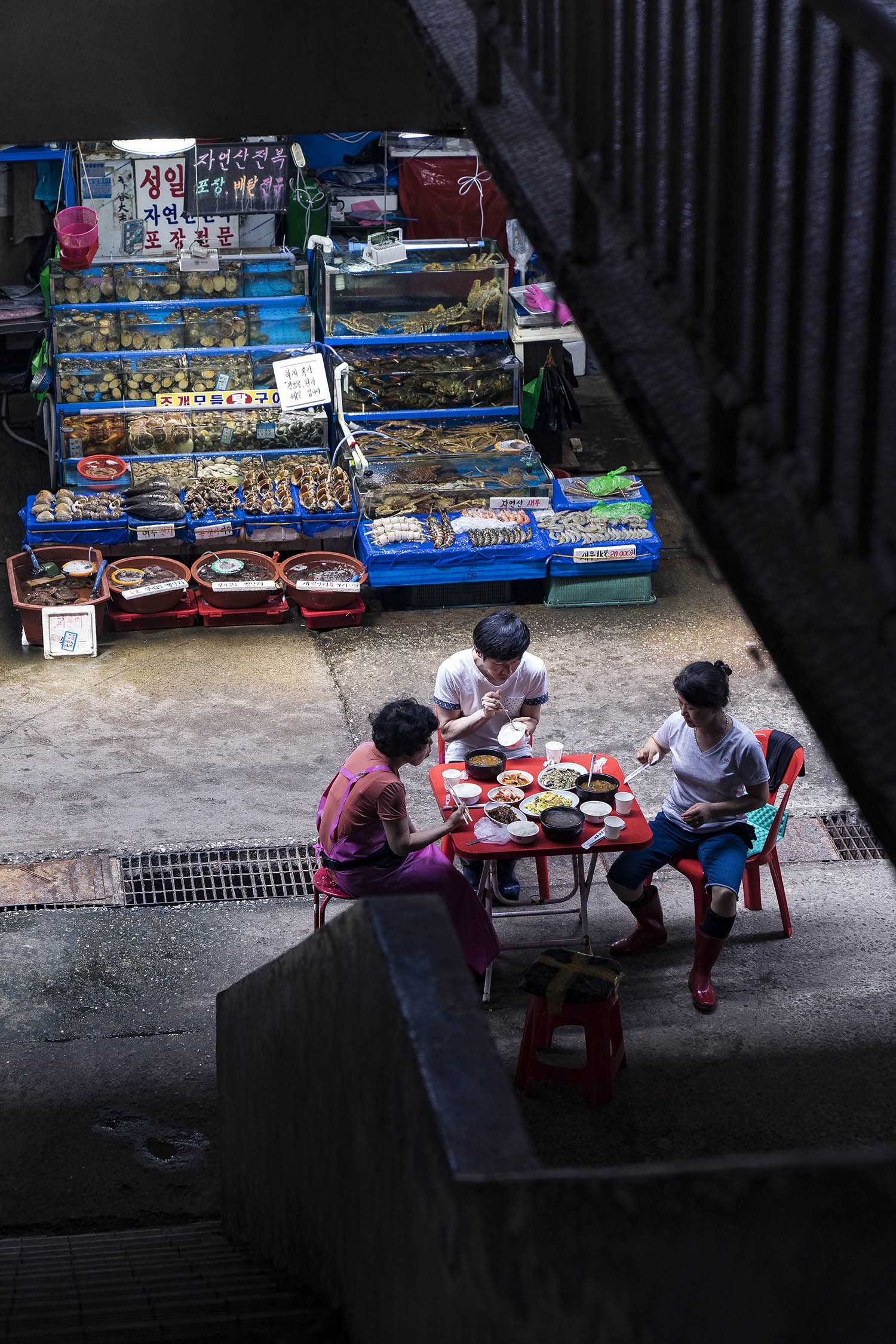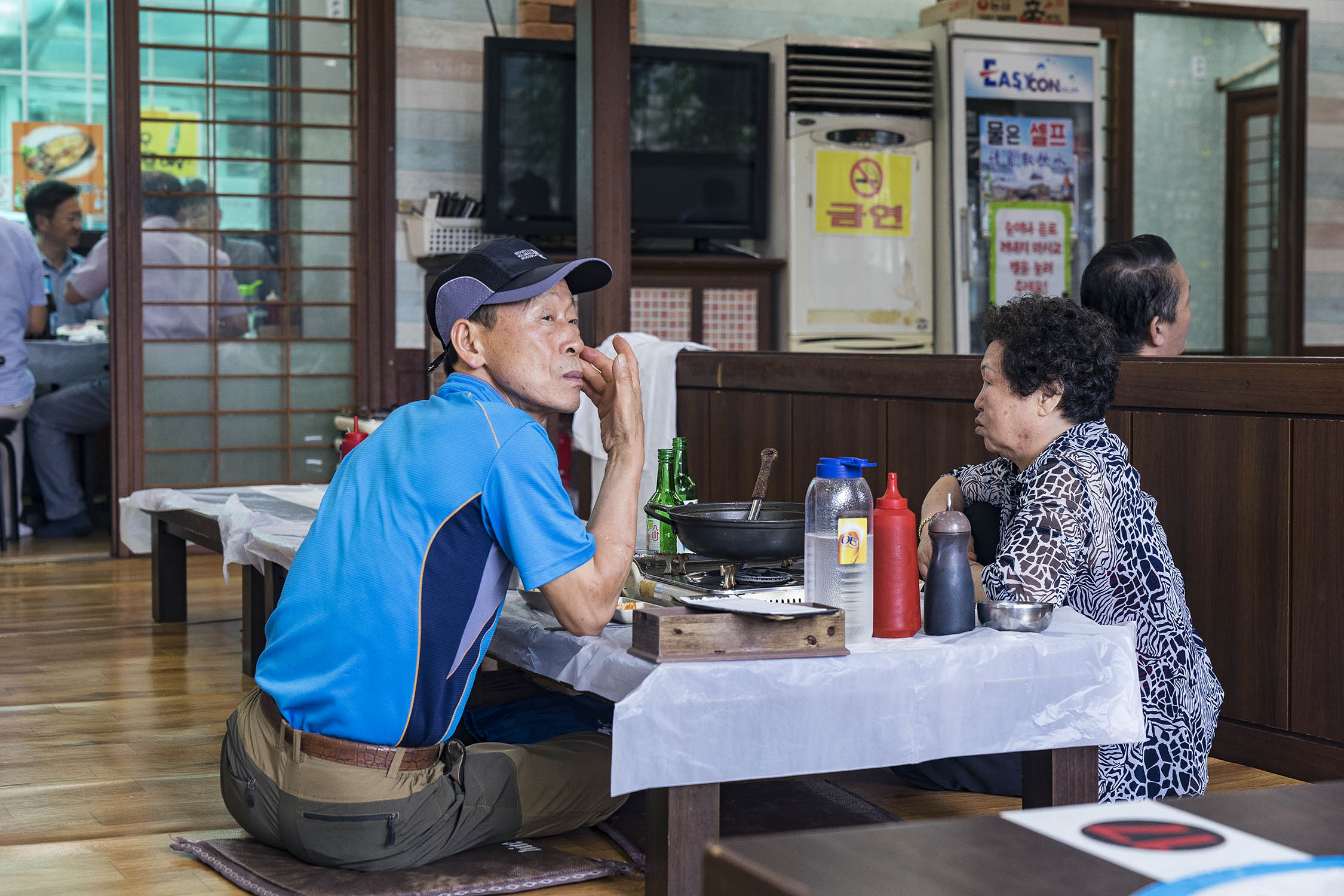FACE-OFF BETWEEN OLD AND NEW // SEOUL
There are two things that strike you as you enter Seoul’s Noryangjin Fish Market: the salty, fresh smell of the sea and two opposing signs marking the path to the entrance, each pointing in different directions.
It’s a puzzling choose-your-own-adventure for unaware tourists. If you follow the red arrows right, down the dusty, dark stairs, you’ll encounter the old traditional market. Originally created in 1927 before moving to this current spot in 1971, it’s known as one of Korea’s largest seafood markets – packed with local vendors who’ll cheerfully try and sell you all sorts of strange edible sea creatures, from shellfish and stingrays to sticky, wiggling octopuses.
Sea urchins, abalone and more fresh shellfish
Delightfully known as 'penis fish'
If you follow the yellow signs that point left, over the traditional market’s rooftop, you’ll find yourself staring at a looming, multi-story, space-ship-like building. This is the new and “improved” fish market, built by the National Federation of Fisheries Cooperation, known as Suhyup.
Opened last year to a chorus of elderly protestors, the $455 million facility stands just next door, casting a grimacing shadow over the old market. Its eight levels were intended to house all the old vendors, plus a floor of seafood restaurants, an events space, offices and room for parking. But in the year that’s passed since it’s unceremonious opening, many vendors have refused to move into the new building, arguing that the new stall spaces were too small to display their tanks, and rent prices were too high – increased by 150 per cent. Despite Suhyup’s claims the old marketplace is unsafe and unsanitary, on opening day, the ABC reported that only eight of 680 vendors moved into their new plots.
I was confused at first, having only read a few older blogs revelling in Noryangjin seafood market’s liveliness, boasting an average of 30,000 visitors a day and an exciting 3am tuna auction similar to the one famously held at Tokyo’s Tsukiji fish market. Open 24 hours a day, every day, I was told it was a continually buzzing marketplace with room for almost 700 seafood vendors to hawk their daily catch. On our visit, while it was still a sight to see, the stalls were half-empty and, apart from a handful of locals, we were the only tourists.
Vendors, cutely clad in pink aprons and protective gumboots (the floor prone to a bit of blood and guts), will wave you over to their collection of bubbling tanks and icy shelves, often forcing a selfie with one of their giant King crabs or convince you to purchase a bag of prawns for lunch.
If you know me or are a follower of Strangertalk, you’ll have rightly guessed that Leigh and I were, and always will be, supporters of the oldies only. But we took a wander over to the new market, just for shits and giggles. We were there for about 5 mins. It’s air conditioned, which, in Seoul’s sweaty humid summer, was a nice break, but the fluorescent lights and white walls made it sterile and, frankly, boring.
The pickled fish section was the most intriguing (and aromatic) section
Now, more than 200 vendors have crossed over to the dark side, resulting in labels of ‘traitors’ and ‘betrayers’ from their old stall mates. It’s busier than the other market, but with much less soul. There were no circles of men taking a break from their stalls to play a game of checkers, there were no gossiping old aunties slurping noodles or having a snooze during the quiet period. There were, curiously, a lot of security guards pacing the floors and monitoring the doorways. Perhaps not so curiously, as I later read about a prior murder attempt by a merchant on one of the Suhyup officials.
Back at the traditional market, all seemed fairly peaceful. We returned to our favourite vendor, Pearl, to buy our seafood lunch from her bounty. The cool way the Noryangjin fish market works is you can choose your seafood fresh out of the tanks, then cart it off to a nearby restaurant kitchen who will cook it up for you for just 3000 Won (about $3). Pearl had a connection with a cheerful, 50-something man wearing a vest that deemed him a restaurateur. When we asked if they had to move to the new market, his cheer turned to defiance. “We will not move!” he demanded. “Here it’s much better, more traditional,” he said, with passion. We didn’t ask any more questions.
He gave our bag of squirming octopuses to another vested man, who immediately jetted off beckoning us to follow. We ended up at a restaurant just behind the old fish market, a sit-on-the-floor, plastic-covered table kind of joint, where plates of pickles, perilla leaves and a spicy gochujang sauce instantly arrived. Our octopus arrived in the form of raw sashimi, known as sannakji – chopped up but still squirming from their still-active nerves. Sannakji is considered a Korean delicacy, but to me it lacked the tender meatiness from a larger grilled octopus tentacle, it was sticky, chewy and a little bland. The seashells came steaming hot, with a pair of small tongs to precariously pinch out the piping hot meat from the shell. It was like biting into a bouncy, salty meatball, and was best dipped in its accompanying bowl of sesame oil.
Sadly my non-existent Korean was unable to get a more personal insight into the current state of the controversial fish markets, but it seems many of the vendors are not willing to talk on the record anyway. This quote from the Korean Herald sums up my thoughts pretty succinctly. '“A market should be like a market, not a department store,” said a 52-year-old fishmonger in the old market, who wished to be identified by only his surname Kim. “Yes, the facility is in a bad condition, but we can improve it by renovating this place. Would you clear out Gyeongbokgung Palace just because it is old?"'
We left via the upstairs level of old restaurants, now depressingly gutted and dusty, with blacked out windows and signs pasted on the walls saying ‘to be demolished’ and ‘it is illegal to conduct business here’.
It was a gloomy view of what will most likely be the future of these staunch vendors. Suhyup have been in the process of taking legal action to fine the vendors and push them out to make room for their new development, and officials have also been known to vandalise the traditional market (you’ll notice graffiti all over the walls) and cut the old vendors’ access to water. For now it seems like their passion is keeping them in their old home, and the two markets are stuck in an awkward, angry stalemate. But who knows when that will change, and when 90 years of history, colour and tradition will be lost to a clean, new world.
Photography: Leigh Griffiths
Words: Eloise Basuki
All words and images are under copyright © 2019 strangertalk.co





